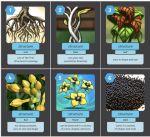Structures and Functions Matching Cards Activity
This activity is designed for teaching the functions of basic plant structures. The activity uses two types of matching cards containing either
a) Structures - depictions of plant structures
b) Functions - descriptions of the function of plant structures
Using the downloadable PDF (including instructions for printing) you can make one set of cards per student or per student group, and students can cut out their own cards.
This activity can stand on its own, or if you are teaching the Investigating Brassicas Around the World lesson, you can extend this activity by instructing students to match their Structure/Function pairs with the Brassica vegetables they observed in the lesson.
This activity can also be used to begin a discussion about how plant breeding focuses on different plant structures, which has contributed to the variation we observe in different Brassica vegetables.
- NGSS.4.LS1.1 Construct an argument that plants and animals have internal and external structures that function to support survival, growth, behavior, and reproduction. [Clarification Statement: Examples of structures could include thorns, stems, roots, colored petals, heart, stomach, lung, brain, and skin.] [Assessment Boundary: Assessment is limited to macroscopic structures within plant and animal systems.]
- NGSS.MS.LS1.4 Use argument based on empirical evidence and scientific reasoning to support an explanation for how characteristic animal behaviors and specialized plant structures affect the probability of successful reproduction of animals and plants respectively. [Clarification Statement: Examples of behaviors that affect the probability of animal reproduction could include nest building to protect young from cold, herding of animals to protect young from predators, and vocalization of animals and colorful plumage to attract mates for breeding. Examples of animal behaviors that affect the probability of plant reproduction could include transferring pollen or seeds, and creating conditions for seed germination and growth. Examples of plant structures could include bright flowers attracting butterflies that transfer pollen, flower nectar and odors that attract insects that transfer pollen, and hard shells on nuts that squirrels bury.]

Comments